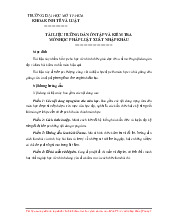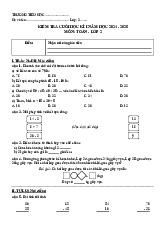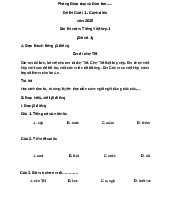


Preview text:
lOMoARcPSD| 40615597 Microeconomics
Chapter 1: Ten Principles of Economics
Name:……………………………. Class:……………………………
1. Economics deals primarily with the concept of a. change. b. power. c. poverty. d. scarcity. 2. Scarcity exists when a. the price of a good rises.
b. society can meet the wants of every individual.
c. there is less of a good or resource available than people wish to have.
d. there is less than an infinite amount of a resource or good.
3. Economics is defined as the study of
a. how society manages its scarce resources. b. business. c. central planning. d. government regulation.
4. The opportunity cost of an item is
a. what you give up to get that item.
b. always equal to the dollar value of the item.
c. always less than the dollar value of the item.
d. the number of hours needed to earn the money to buy it.
5. Ryan spends an hour studying instead of going for a bike ride. The opportunity cost to him of studying is
a. the improvement in his grades from studying for the hour.
b. the enjoyment and exercise he would have received had he gone for a bike ride.
c. the difference between the improvement in his grades from studying minus the enjoyment of a bike ride.
d. zero. Since Ryan chose to study rather than to ride his bike, the value of
studying must have been greater than the value of the bike ride.
6. A rational decision maker takes an action only if the
a. marginal benefit is greater than the marginal cost.
b. average benefit is greater than the average cost. lOMoARcPSD| 40615597 1
c. marginal benefit is less than the marginal cost.
d. marginal benefit is greater than both the average cost and the marginal cost.
7. Economists understand that people respond to
a. the wishes of policymakers.
b. tax breaks, but not tax hikes. c. threats more than rewards. d. incentives.
8. Which is the most accurate statement about trade?
a. Trade can make every nation better off.
b. Trade makes some nations better off and others worse off.
c. Trade helps rich nations and hurts poor nations.
d. Trading for a good can make a nation better off only if the nation cannot produce that good.
9. In a market economy, economic activity is guided by a. the government. b. corporations. c. central planners. d. prices.
10. One advantage market economies have over central planning is that market economies
a. solve the problem of scarcity. b. are more efficient.
c. establish government economic control.
d. provide an equal distribution of goods and services to consumers.
11. The term market failure refers to
a. an unsuccessful advertising campaign.
b. a situation in which the market on its own fails to allocate resources efficiently.
c. a situation in which competition among firms becomes ruthless.
d. a firm which is forced out of business because of losses.
12. The two best reasons for a government to intervene in a market are to
a. promote equity and to raise revenues.
b. promote equity and to promote efficiency.
c. promote efficiency and to raise revenues.
d. raise revenues and to promote stability. lOMoARcPSD| 40615597
13. The income of a typical worker in a country is most closely linked to which of the following? a. population b. government policies c. labor unions d. productivity
14. Almost all variation in living standards is attributable to differences in countries’ a. population growth rates.
b. endowments of natural resources. c. defense budgets. d. productivity.
15. Productivity is defined as the
a. amount of goods and services produced from each hour of a worker’s time.
b. number of workers required to produce a given amount of goods and services.
c. amount of labor which can be saved by replacing workers with machines.
d. actual amount of effort workers put into an hour of working time.




